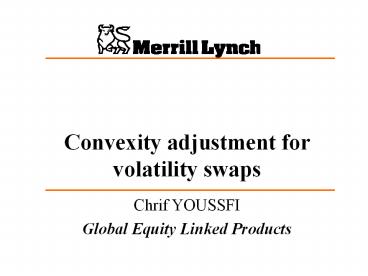Chrif YOUSSFI PowerPoint PPT Presentation
Title: Chrif YOUSSFI
1
Convexity adjustment for volatility swaps
- Chrif YOUSSFI
- Global Equity Linked Products
2
Outline
- Generalities about volatility/variance swaps.
- Intuition and motivation
- The framework of stochastic volatility.
- Convexity adjustment under stochastic volatility.
- Convexity adjustment and current smile.
- Numerical results.
- Conclusions.
3
Volatility and Variance Swaps
- A volatility swap is a forward contract on the
annualized volatility that delivers at maturity - A variance contract pays at maturity
- The annualized volatility is defined as the
square root of the variance - where is the closing price of the
underlying at the ith business day and (n1) is
the total number of trade days.
4
Hedge and Valuation
- When there no jumps, the variance swaps valuation
and hedging are model independent. - The vega-hedge portfolio for variance swaps is
static and the value is directly calculated from
the current smile. - The valuation of a volatility swap is model
dependent and the pricing requires model
calibration and simulations. - The vega hedge portfolio is not static.
5
Motivation
Smile of volatility generated by a stochastic
volatility model wherespot is 100,maturity 1y
and correlation is estimated at -70
- What is the price of ATM option?
By considering the linearity of the option price
w.r.t. volatility, the price is approximately
14.11
- What is the value of the variance swap? 16.17.
- What is the value of the volatility Swap? More
difficult.
6
Intuition
- is the spot density at maturity T and
the diffusion factor which be stochastic - A rough estimation of the volatility swap
- Question What can the moments of the implied
volatility teach us about the value of volatility
swap?
The weighting is not exact.
7
MIV Moment of Implied Volatility
- We define by MIV (n) as the nth moment of the
implied volatility weighted by the risk neutral
density. - We define the smile convexity by
- The convexity adjustment for the volatility
swaps - Question What is the relation between
and ?
8
Stochastic volatility assumptions
- The underlying dynamics are
- The volatility itself is log-normal
- with the initial condition
and - The dynamics correspond to the short time
analysis and the factor can be considered
proportional to the square root of time to
maturity. - (Patrick Hagan Model (1999))
9
Forward and backward equations
- The backward equation for the call prices is
- The transition probability
from the state - to satisfies the
forward equation (FPDE) - When integrating the Forward PDE (Tanakas
formula)
The curve
Smile effect
Intrinsic
Integral over calendar spreads
10
Call Price and Implied Volatility
- Define by
-
and - The solution of the system (S) is
- In the BS case we have a similar formula with
11
Volatility swap convexity adjustment
- The expected variance under the model
assumptions - The value of the expected volatility
- It follows that the convexity adjustment is
12
Smile convexity
- By considering the value of the log-contract and
the square of the log-profile - The smile convexity of the implied volatility is
13
Convexity adjustment
- As long as the is large enough (which is
satisfied in the equity markets), to the leading
orders show that the relation between the two
convexities is very simple - There no dependencies on maturity and volatility
of the volatility. - The value of the volatility swap does not depend
on the correlation, however the implied
volatility depends on and therefore
intuitively we need to strip off this dependency.
14
Numerical Results (4)
15
Numerical Results (5)
16
Numerical Results(6) Heston
17
Numerical Results (7) Heston
18
Conclusion
- This analysis shows that option prices can be
very insightful to estimate the convexity
adjustment. - Even though the results are derived in the case
of Hagan model, they can be extended to other
models of stochastic volatility (Heston) as long
as the correlation is in an appropriate range. - It sheds some light on the importance of the
curve factors to decide the value of a volatility
swap.

